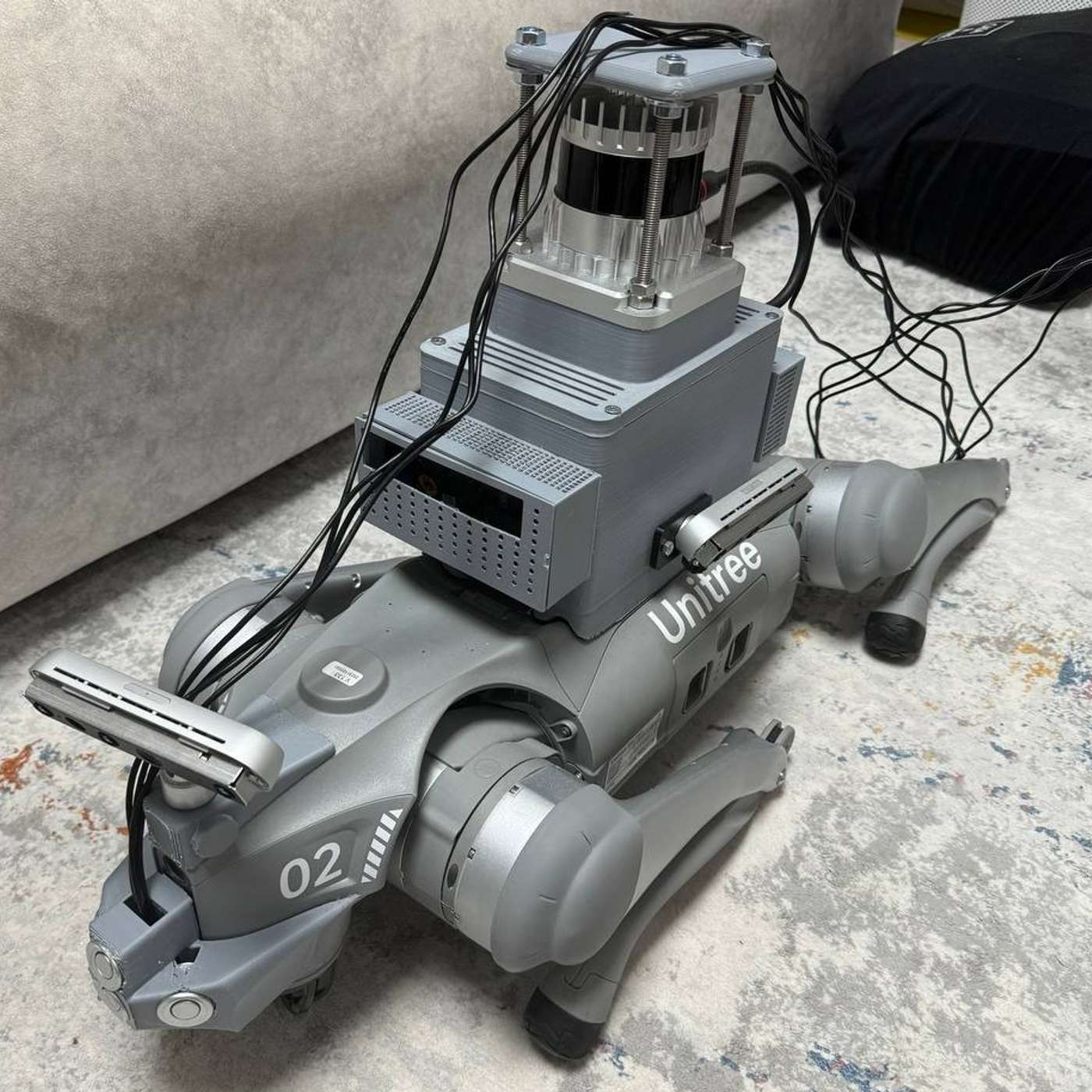Discover Futurism Tech Brief By HackerNoon
Futurism Tech Brief By HackerNoon

166 Episodes
Reverse
This story was originally published on HackerNoon at: https://hackernoon.com/how-teodor-calins-new-company-vulture-labs-is-making-every-camera-proactive.
Romanian engineer and researcher Teodor Calin is the co-founder of Vulture Labs, a start-up that’s turning ordinary cameras into intelligent systems.
Check more stories related to futurism at: https://hackernoon.com/c/futurism.
You can also check exclusive content about #spatial-computing, #teodor-calin, #vulture-labs, #intelligent-systems, #video-footage, #camera-tech, #ai-cameras, #good-company, and more.
This story was written by: @stevebeyatte. Learn more about this writer by checking @stevebeyatte's about page,
and for more stories, please visit hackernoon.com.
Romanian engineer and researcher Teodor Calin is the co-founder of Vulture Labs, a start-up that’s turning ordinary cameras into intelligent systems.
This story was originally published on HackerNoon at: https://hackernoon.com/how-to-hack-cheap-car-parking-sensors-with-arduino-and-an-oscilloscope.
Learn how to reverse engineer and utilize the cheapest waterproof ultrasonic sensors on the market for your robotics projects.
Check more stories related to futurism at: https://hackernoon.com/c/futurism.
You can also check exclusive content about #robotics, #arduino, #pwm-signals, #ultrasonic-sensors, #reverse-engineering, #sensor-data-decoding, #how-to-hack-parking-sensors, #robotics-project-for-beginners, and more.
This story was written by: @nuralem. Learn more about this writer by checking @nuralem's about page,
and for more stories, please visit hackernoon.com.
Learn how to decode data from car parking sensors by reverse engineering cheap ultrasonic sensors. This comprehensive guide provides step-by-step instructions, Arduino sketches, and insights into understanding PWM signals, making it perfect for robotics enthusiasts and engineers.
This story was originally published on HackerNoon at: https://hackernoon.com/nobel-prize-winner-forms-alliance-with-hpe-and-chipmakers-to-build-scalable-quantum-computers.
HPE and Nobel physicist John Martinis launch a Quantum Scaling Alliance to mass-produce quantum supercomputers using chip-industry tools.
Check more stories related to futurism at: https://hackernoon.com/c/futurism.
You can also check exclusive content about #quantum-computing, #scalable-quantum-computers, #quantum-scaling-alliance, #qubit-technology, #hpe-quantum, #quantum-hardware, #ibm-quantum-research, #google-quantum-computing, and more.
This story was written by: @techannouncements. Learn more about this writer by checking @techannouncements's about page,
and for more stories, please visit hackernoon.com.
Nobel Prize–winning physicist John Martinis has partnered with HPE and key semiconductor firms to form the Quantum Scaling Alliance, a consortium focused on mass-producing quantum computers. By applying industrial chip-fabrication techniques to quantum chip design, the group aims to move beyond bespoke, lab-built systems toward scalable, commercially viable machines capable of solving complex problems in chemistry, medicine, and data science.
This story was originally published on HackerNoon at: https://hackernoon.com/the-internet-of-things-humanitys-new-nervous-system.
Dive into the IoT of the modern World. Understand the technology, architecture, benefits, and critical security concerns
Check more stories related to futurism at: https://hackernoon.com/c/futurism.
You can also check exclusive content about #iot, #smart-cities, #iiot, #iot-architecture, #edge-computing, #industry-4.0, #iot-security, #internet-of-medical-things, and more.
This story was written by: @adzeikalo. Learn more about this writer by checking @adzeikalo's about page,
and for more stories, please visit hackernoon.com.
The Internet of Things (IoT) aims to make ordinary objects "smart," enabling them to collect data about everything and interact with each other and with people. The scope of IoT implementation is so broad that it creates its own areas and directions.
The biggest challenge is ensuring Security and Confidentiality. Since IoT is deeply embedded in critical infrastructure, addressing vulnerabilities like weak authentication and protecting vast amounts of sensitive data is an absolute imperative for future growth.
This story was originally published on HackerNoon at: https://hackernoon.com/quantitative-and-qualitative-results-sage-outperforms-sota-in-full-body-3d-avatar-reconstruction.
This article presents the quantitative and qualitative results for the SAGE model across three evaluation settings
Check more stories related to futurism at: https://hackernoon.com/c/futurism.
You can also check exclusive content about #ar, #3d-avatar-generation, #sparse-observations, #head-mounted-devices-(hmds), #full-body-reconstruction, #kinematic-tree, #smpl-model, #latent-diffusion-model, and more.
This story was written by: @zaddy. Learn more about this writer by checking @zaddy's about page,
and for more stories, please visit hackernoon.com.
This article presents the quantitative and qualitative results for the SAGE model across three evaluation settings
This story was originally published on HackerNoon at: https://hackernoon.com/nasas-next-great-observatory-could-detect-alien-solar-power-systems.
Investigating the amount of solar radiation that would power Earth and the possibility of detecting extraterrestrial solar panels from a distance of light years
Check more stories related to futurism at: https://hackernoon.com/c/futurism.
You can also check exclusive content about #extraterrestrial-intelligence, #exoplanet-detection, #silicon-solar-panels, #photovoltaic-signatures, #spectral-reflectance, #solar-energy-on-exoplanets, #kardashev-scale, #energy-growth-modeling, and more.
This story was written by: @magnetosphere. Learn more about this writer by checking @magnetosphere's about page,
and for more stories, please visit hackernoon.com.
This study investigates the detectability of silicon-based photovoltaics as technosignatures on exoplanets and measures the global energy potential of solar panels. Covering just 2.4% of Earth's land may meet global energy demands in 2022 with an average solar power density of 5.4 W/m2, while covering 23% would far surpass human needs.
This story was originally published on HackerNoon at: https://hackernoon.com/sage-stratified-avatar-generation-for-full-body-3d-reconstruction-from-sparse-hmd-data.
This paper introduces Stratified Avatar Generation, a novel, decoupled two-stage approach for reconstructing 3D full-body avatars from sparse HMD observations
Check more stories related to futurism at: https://hackernoon.com/c/futurism.
You can also check exclusive content about #ar, #3d-avatar-generation, #sparse-observations, #head-mounted-devices-(hmds), #full-body-reconstruction, #kinematic-tree, #smpl-model, #latent-diffusion-model, and more.
This story was written by: @zaddy. Learn more about this writer by checking @zaddy's about page,
and for more stories, please visit hackernoon.com.
This paper introduces Stratified Avatar Generation, a novel, decoupled two-stage approach for reconstructing 3D full-body avatars from sparse HMD observations
This story was originally published on HackerNoon at: https://hackernoon.com/are-3d-holograms-the-next-big-tech-leap.
Users will no longer need to confine themselves to isolated bubbles.
Check more stories related to futurism at: https://hackernoon.com/c/futurism.
You can also check exclusive content about #mixed-reality, #hologram, #apple-vision-pro, #holographic-technology, #future-of-entertainment, #immersive-technologies, #3d-innovation, #arvr-evolution, and more.
This story was written by: @allan-grain. Learn more about this writer by checking @allan-grain's about page,
and for more stories, please visit hackernoon.com.
Holograms will turn movies, TV shows, and even live concerts into fully immersive VR formats. 3D tech will become a tool for collaboration and not a technology used for escapism.
This story was originally published on HackerNoon at: https://hackernoon.com/how-telegram-built-the-super-app-silicon-valley-couldnt.
How a messaging platform achieved what Silicon Valley couldn't: building a functional super app ecosystem in 18 months using crypto and viral gaming strategies.
Check more stories related to futurism at: https://hackernoon.com/c/futurism.
You can also check exclusive content about #platform-economy, #messaging-platforms, #crypto-infrastructure, #blockchain-technology, #super-apps, #telegram-super-app, #ton-blockchain, #hackernoon-top-story, and more.
This story was written by: @johnwrites. Learn more about this writer by checking @johnwrites's about page,
and for more stories, please visit hackernoon.com.
A messaging platform succeeded where tech giants failed by leveraging crypto infrastructure and tap-to-earn gaming to create a super app ecosystem. While executives spent billions trying to replicate Asian models, this platform attracted hundreds of millions through mini apps and blockchain integration, completing in 18 months what took others over a decade.
This story was originally published on HackerNoon at: https://hackernoon.com/vyanas-replace-dont-dilute-smart-vent-could-redefine-home-air-quality.
Vyana’s smart vent replaces stale indoor air with filtered fresh air using predictive sensors and dual-fan control—cutting CO₂, pollen, and HVAC costs.
Check more stories related to futurism at: https://hackernoon.com/c/futurism.
You can also check exclusive content about #vyana-smart-vent, #indoor-air-quality-tech, #replace-don't-dilute, #arjun-gupta-vyana, #smart-home-air-control, #predictive-ventilation-system, #energy-efficient-air-exchange, #good-company, and more.
This story was written by: @jonstojanjournalist. Learn more about this writer by checking @jonstojanjournalist's about page,
and for more stories, please visit hackernoon.com.
Vyana, founded by Arjun Gupta, introduces a smart ventilation system that replaces, not dilutes, indoor air. Using CO₂, VOC, and pollen sensors with predictive algorithms, it optimizes airflow for health and energy savings (~15% in early tests). With sealed dampers, washable filters, and $250–$300 pricing, Vyana aims to make fresh air an algorithmic decision.
This story was originally published on HackerNoon at: https://hackernoon.com/building-a-dvbss2-demodulator-from-scratch-a-journey-through-sdr-fpga-and-signal-processing.
A deep dive into building a DVBS/S2 demodulator from scratch using SDR, FPGA, and signal processing—covering design choices, workflow, and testing.
Check more stories related to futurism at: https://hackernoon.com/c/futurism.
You can also check exclusive content about #hardware, #dvbs2-demodulator, #sdr, #fpga, #signal-processing, #zynqberry, #rtl-sdr, #petalinux, and more.
This story was written by: @hacker84199059. Learn more about this writer by checking @hacker84199059's about page,
and for more stories, please visit hackernoon.com.
A deep dive into building a DVBS/S2 demodulator from scratch using SDR, FPGA, and signal processing—covering design choices, workflow, and testing.
This story was originally published on HackerNoon at: https://hackernoon.com/turning-apparel-waste-into-bricks-a-step-toward-greener-industrial-practices.
Kosalee Galkaduwa’s innovative research turns apparel sludge into construction bricks, cutting waste and paving the way for sustainable industry practices.
Check more stories related to futurism at: https://hackernoon.com/c/futurism.
You can also check exclusive content about #apparel-waste-recycling, #sustainable-brick-manufacture, #kosalee-galkaduwa, #waste-to-value-innovation, #apparel-sludge-reuse, #circular-economy-in-fashion, #procurement-practices, #good-company, and more.
This story was written by: @kashvipandey. Learn more about this writer by checking @kashvipandey's about page,
and for more stories, please visit hackernoon.com.
Former Omegaline procurement manager Kosalee Galkaduwa has pioneered a method to turn apparel sludge into eco-friendly bricks, achieving up to 5.0 MPa compressive strength. Her sustainability initiatives cut factory waste by 20%, align with ISO 9001, and prove industrial byproducts can fuel a circular economy—redefining how apparel waste powers green innovation.
This story was originally published on HackerNoon at: https://hackernoon.com/why-classical-excess-could-be-the-next-big-tool-in-quantum-research.
New research defines a resource theory of generalized contextuality in GPT systems, introducing “classical excess” as a key measure.
Check more stories related to futurism at: https://hackernoon.com/c/futurism.
You can also check exclusive content about #quantum-contextuality, #quantum-information-theory, #general-probabilistic-theories, #resource-theory, #classical-excess, #prepare-and-measure-scenarios, #univalent-simulations, #contextuality-monotones, and more.
This story was written by: @probabilistic. Learn more about this writer by checking @probabilistic's about page,
and for more stories, please visit hackernoon.com.
This article presents a new resource theory of generalized contextuality for GPT systems, framing noncontextuality as free resources and univalent simulations as free operations. A novel measure—“classical excess”—emerges to quantify contextuality, alongside the POM success probability. The authors explore how information erasure could explain fine-tuning in contextuality and propose experimental tests for heat dissipation. They also situate their framework within broader resource theories like entanglement, highlighting potential future directions in quantum information and foundational physics.
This story was originally published on HackerNoon at: https://hackernoon.com/the-science-of-causality-and-the-resetting-of-karma-a-manifesto-for-a-new-way-of-thinking.
What if karma isn’t a moral law — but an engineering problem?
Check more stories related to futurism at: https://hackernoon.com/c/futurism.
You can also check exclusive content about #consciousness, #quantum-biology, #the-neural-awakening, #karma, #futurism-and-spirituality, #mind, #neuroscience, #paradigm-shift, and more.
This story was written by: @hacker86877327. Learn more about this writer by checking @hacker86877327's about page,
and for more stories, please visit hackernoon.com.
What if karma isn’t a moral law — but an engineering problem?
This manifesto proposes a radical idea: karma is a field recording in the continuum of causality, and it can be reset — not through prayer or penance, but through total field isolation.
Supported by cutting-edge neuroscience — including evidence that microtubules in our brain operate at the quantum level — I argue that ancient structures like the Serapeum may have been devices for disconnecting from reality’s causal network.
This is not mysticism. It’s a scientific hypothesis with revolutionary implications for how we understand consciousness, responsibility, and freedom.
This story was originally published on HackerNoon at: https://hackernoon.com/why-ai-anxiety-may-outlast-every-past-wave-of-technophobia.
We fear AI like every great technology before it. But what if fear isn’t a stop sign, but a signal that progress and new levels of thought lie ahead?
Check more stories related to futurism at: https://hackernoon.com/c/futurism.
You can also check exclusive content about #ai-anxiety, #critical-thinking, #future-of-ai, #ai-and-humanity, #technophobia, #pros-and-cons-of-ai, #ai-and-creativity, #ai-vs-humans, and more.
This story was written by: @dawnteh. Learn more about this writer by checking @dawnteh's about page,
and for more stories, please visit hackernoon.com.
Every great technology sparks panic, but fear isn’t necessarily a stop sign. It’s a signal to be brave and open our minds to possibility.
This story was originally published on HackerNoon at: https://hackernoon.com/building-a-raspberry-pi-esp32-drone-my-first-steps-into-robotics.
A journey from a web developer to a drone maker, with all of the problems and solutions that come with making a drone using a Raspberry Pi and ESP32.
Check more stories related to futurism at: https://hackernoon.com/c/futurism.
You can also check exclusive content about #robotics, #drones, #c++, #kotlin, #raspberry-pi, #esp32, #android-development, #hackernoon-top-story, and more.
This story was written by: @tohntobshi. Learn more about this writer by checking @tohntobshi's about page,
and for more stories, please visit hackernoon.com.
Anton wrote about his first steps into robotics and particularly about his Raspberry Pi + ESP32 drone. Anton designed parts in Blender and then printed them in 3D on a cheap 3D printer. The drone is controlled by an app, where users can monitor and monitor the drone with an analog-like app. Anton also made a video about it and attached it at the end of the article to the article.
This story was originally published on HackerNoon at: https://hackernoon.com/advanced-nonlinear-feedback-control-techniques-for-automated-vehicles.
This paper explores the application of nonlinear feedback controllers (NLFCs) for automated vehicle control on straight and circular roads.
Check more stories related to futurism at: https://hackernoon.com/c/futurism.
You can also check exclusive content about #automation, #automated-vehicles, #microscopic-simulation, #nonlinear-feedback-controller, #vehicle-modeling, #traffic-flow-optimization, #vehicle-control-systems, #trafficfluid-sim, and more.
This story was written by: @escholar. Learn more about this writer by checking @escholar's about page,
and for more stories, please visit hackernoon.com.
The nonlinear feedback controllers (NLFCs) are designed for real-time vehicle control on straight and circular roads. The straight-road NLFC ensures collision avoidance and speed control, while the circular-road NLFC handles circular movement and adaptive speed adjustments. Vehicle nudging and iso-distance modifications enhance safety and traffic flow.
This story was originally published on HackerNoon at: https://hackernoon.com/from-walled-gardens-to-world-grid-a-short-history-of-how-we-centralized-the-internet.
From ARPANET’s open roots to today’s walled gardens, explore how we centralized the internet—and why the fight for a freer web isn’t over.
Check more stories related to futurism at: https://hackernoon.com/c/futurism.
You can also check exclusive content about #future-of-the-internet, #decentralized-internet, #internet-history, #centralization, #open-web, #digital-sovereignty, #development-of-internet, #hackernoon-top-story, and more.
This story was written by: @ibukun8717. Learn more about this writer by checking @ibukun8717's about page,
and for more stories, please visit hackernoon.com.
The internet began decentralized, designed to survive disruption. Over decades, it centralized into walled gardens and fragile empires. Yet seeds of resistance—open source, peer-to-peer, Bitcoin, IPFS—show the web’s DNA was always meant to be free. This prequel traces the path from bazaar to World Grid, setting the stage for a decentralized future.
This story was originally published on HackerNoon at: https://hackernoon.com/the-spatial-web-protocol-ushering-in-a-new-era-of-internet-and-ai-integration.
VERSES AI is transforming AI, shifting us towards First Principles AI, Embodied AI, and Decentralized AI, distributing AI compute to Edge devices.
Check more stories related to futurism at: https://hackernoon.com/c/futurism.
You can also check exclusive content about #spatial-computing, #active-inference-ai, #decentralized-ai, #ai-education, #spatial-web-protocol, #decntralized-ai, #verses-ai, #first-principles-ai, and more.
This story was written by: @deniseholt. Learn more about this writer by checking @deniseholt's about page,
and for more stories, please visit hackernoon.com.
This next era of our internet — the Spatial Web Protocol — enables the programmable context for the grounding of multitudes of distributed intelligent agents working together across our internet, pushing computational resources to the edge, incorporating real data from anywhere, while maintaining a baseline of real knowledge, enabling an integrated system that is ever-evolving, adaptable, auditable, and functioning in cooperation with human guidance.
This story was originally published on HackerNoon at: https://hackernoon.com/7-consequences-of-autonomous-trucks-in-the-supply-chain.
Do you want to see self-driving trucks on the road, or do you prefer human drivers? Here are the pros and cons of autonomous trucks in the supply chain.
Check more stories related to futurism at: https://hackernoon.com/c/futurism.
You can also check exclusive content about #self-driving-cars, #autonomous-vehicle, #trucking, #ai, #supply-chain, #supply-chain-management, #shipping, #driverless-trucks, and more.
This story was written by: @zacamos. Learn more about this writer by checking @zacamos's about page,
and for more stories, please visit hackernoon.com.
Self-driving cars are a difficult challenge to create, but autonomous long-haul trucks could arrive sooner. On the positive side, they'll improve safety and shipping speeds, help reduce worker shortages, and boost supply chain sustainability. Unfortunately, there will also be regulatory complications, job losses, and safety challenges as self-driving AI develops.
























